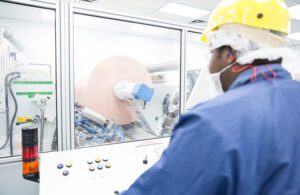
Compliance with the EU’s MDR often requires multidisciplinary collaboration between a device maker’s operations, R&D, regulatory and quality teams, plus partners across the supply chain. [Photo courtesy of Avery Dennison Medical]
With the Medical Device Regulation in effect, European Union regulatory compliance requires rigorous attention and cross-functional collaboration.
Lisa Bartakovics, Avery Dennison Medical
Are you ready for MDR? That question has weighed on medical device manufacturers ever since the European Union proposed stronger device regulations and requirements.
After MDR became law in May 2017, the industry had four years to transition and comply. It’s been more than a year since MDR’s May 26, 2021, application date, yet there still is uncertainty regarding compliance requirements due to the lack of guidance documents and individual interpretation.
One thing is clear. To successfully comply with MDR, it’s crucial to have: quantitative data; strong quality systems; trusted, transparent supply chains; and a cooperative, collaborative organizational culture.
Why MDR matters
MDR compliance is required to market and sell medical devices in the EU. It applies to all medical devices and their manufacturers regardless of classification, years in business or time on the market.
No devices or companies are “grandfathered.” In other words, manufacturers cannot automatically qualify for MDR certification, even if their devices meet all requirements of the EU’s previous regulatory framework, the Medical Device Directive (MDD). Whereas the MDD was a set of guidelines, the MDR is codified law.
Whether a device is brand new to the EU market or sold there for decades, it must pass the MDR muster. MDR compliance is mandatory for a device to bear the CE mark, confirming the product meets all European health, safety and environmental protection requirements.
MDR’s higher bar
The MDR requires the legal manufacturer of a device to provide an extensive technical dossier about every product it seeks to sell in the EU. For many devices, there are heightened requirements for post-market surveillance and documentation than there were under the MDD. For example, the manufacturer must maintain an updated Summary of Safety and Clinical Performance (SSCP). For Class III and implantable devices, the manufacturer must provide Periodic Safety Update Reports (PSUR).
Generally, if your company’s name or brand appears on the product’s packaging, you are considered the legal manufacturer. The MDR compliance bar has proven so high and daunting for some device makers that they have taken their products off the market, even if their devices sold successfully for many years without issue.
Others have asked trusted contractors to serve as the legal manufacturer for their devices. In some cases, those contractors might be better able to supply and maintain the necessary technical documentation.
The MDR-notified bodies — organizations designated by each EU country to assess device MDR conformity — must have permanent access to all product documentation. It’s a major responsibility with serious repercussions for noncompliance.
Keys to a successful MDR transition
MDR compliance requires teamwork, resources and experience in navigating regulatory complexities. As the EU said in its MDR compliance guide, “Before continuing with the focus on the product, one needs to consider the company or companies that will be developing, potentially producing and ultimately commercializing this product. The expertise required by developers of medical devices is significant. In addition to the general design and engineering expertise, which is required of any industrial products company, medical device developers also require risk management, quality management, medical and regulatory compliance expertise.” How true it is.
Generating, compiling and submitting MDR compliance documentation requires collaboration between teams in regulatory affairs, R&D, quality and operations. In addition, suppliers to the legal manufacturer often must provide documentation of their quality systems, raw materials and processes used to make components. EU notified bodies and auditors are honing MDR compliance and monitoring protocols, so manufacturers must be ready to revise filings and supply additional data as requested.
It can be beneficial to work with partners with knowledge of both MDR and FDA regulatory compliance. Some say the pendulum has swung, and EU compliance is now more difficult to achieve than FDA clearance, whereas it used to be the other way around. It takes knowledge and skill to navigate both frameworks, akin to understanding and playing international rugby and U.S. football. They’re similar games with different rules, but everyone’s in it to win.
As in sports, healthcare regulatory compliance takes a team effort from the start, and executing the plays is a job that’s never finished. Rising to the MDR challenge is an ongoing commitment, just as any patient-centered care and safety priorities should be.

Lisa Bartakovics is the senior director of global regulatory affairs and quality at Avery Dennison Medical. [Photo courtesy of Avery Dennison Medical]
Lisa Bartakovics is the senior director of global regulatory affairs and quality at Avery Dennison Medical (ADM), overseeing regulatory affairs including FDA 510(k) submissions of combination products, Class III Design Dossier approval and international product registrations. She is also responsible for the quality system and quality performance, including document control system standardization and best-process implementation across ADM’s three manufacturing sites in Mentor, Ohio; Turnhout, Belgium; and Longford, Ireland.
The opinions expressed in this post are the author’s only and do not necessarily reflect those of MedicalDesignandOutsourcing.com or its employees.